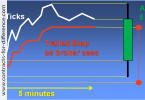Successful traders all agree that correct money management is one of the keys to trading. Placing stop-loss orders not only gives you protection if you are unable to watch an open trade but also gives traders discipline. Stop-loss orders mean that if a trade moves to the stop level the trade will then be closed at a price either exactly (guaranteed stop loss) or as close to the order level as is possible.
A stop loss order is by far one of the most popular order types used by traders to manage risk. Many traders and investors use stop loss techniques to put a cap on the absolute risk. Using this risk management technique, traders can specify the level of loss at which a trade is automatically closed.
Most traders have heard of stop orders, and it’s usually recommended that you use them frequently to prevent runaway losses if your trade does not go in the direction you anticipate. They are commonly called stop loss orders in this function. A stop loss order simply consists of an order to close a position that is set at a price below or higher than the prevailing market price. What you do is to enter a stop order to sell just under the current market price, if you’re taking a long position. If the price doesn’t go up but instead goes down, when it hits the level you set in the stop order, the order becomes a market order to sell. Basically, here you are placing an order to sell at a price that you’re willing to shut out your open position. If you’re taking a short position, then the idea is the same with the stop order above the entry price.
Nobody can watch their trading positions on a 24 hours basis so it is important to make full use of all the different types of automated orders so you do not get caught out. Although this can be painful at the time, the disciplined use of stop loss orders helps overcome the natural tendency of investors and traders to stick with their losses in the hope of a turnaround. Some platforms attempt to mitigate the risks of trading by applying automatic stop losses to every trade; however stops are not usually guaranteed. This means that the actual price that you are taken out of the market is not set. The stop order simply becomes a market order when the price level is reached, and your broker will do his best to sell at a decent price. In a fast-moving market you may find this is some points below the stop loss level you set.
A stop loss should take into consideration the market you are trading, your trading goals, your trading time frame and your risk level.
While this is how most traders learn about and use stop orders, there are some other ways that they can be used to help your trading. For instance, you can use a buy stop order to get into a long position. If the security has been trading in a channel, or is trading in a range between support and resistance, you can place a buy stop order just above the resistance or upper channel line. While the price continues to be constrained this has no effect, but if there should be a breakout to the upside, the buy stop order will become a market order to buy, and you will get in early on the new uptrend. Even though it may seem strange to wait for the price to go up before buying, if there is no breakout then you will have saved the cost of trading.
If you’re looking at a possible short position, you would do the opposite. In this case, you would set a sell short stop order under the support level, and this would trigger if the price broke out to the downside. You can see that in practice it is very similar to the protective stop loss order, which would be placed under recent support to take you out of the position if your long trade was to fail. If you are trading short, then your protective stop would be a buy stop order above the entry price.
You need to read the Product Disclosure statement and the terms and conditions of the client agreement to understand the stop-loss options for a particular CFD and what you might risk if stop-loss orders aren’t guaranteed.
Learning how to place stop orders and knowing which stop orders to utilise in particular trading situations becomes easier with practice. Most experienced traders will use order types in conjunction with their trading strategies. Stop orders help to avoid having to be alwas looking infront of your screen – and ease anxiety.
Some people feel that you should not place stop loss orders in the market, as they can be seen on dealers screens. This leads to the idea of ‘stop loss hunting’, where the prices are manipulated to take you out of the trade before the trade resumes in your anticipated direction. It all depends on how paranoid you are about your trading. Protective stop losses can save you a great deal, so you shouldn’t give them up lightly. It is also important to note that stop loss orders are susceptible to slippage should the market gap through your stop level, this is a frequent occurrence when trading share CFDs.







